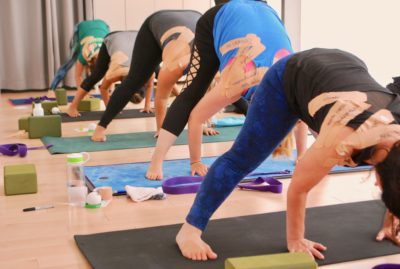
I taught a shoulder anatomy workshop today and it covered anatomy, myofascial release and of course, yoga practice. The format broke up the practice into two sections: first, we practiced and I talked to them about the movements of the shoulders in different poses and then I showed them the muscles in a short powerpoint presentation. We taped them with kinesiotape and then we rolled them with massage therapy balls (MFR balls). We then went back to practice and I could cue them with specific anatomy cues, much more than the ones I had used earlier because they had the benefit of the knowledge from the presentation.
Cues to the shoulder are common in teaching although they are often incorrectly presented. I’m never exactly sure why they’re incorrect; it can be because the teacher is uninformed or perhaps the teacher heard something from another teacher and decided to use it, deferring to them and assuming they know the correct cues to use. Here, I’d like to share a quick review of just cues to the shoulders that you could use when teaching a class. I’ll give you the pose and then give you the cue.
Warrior One: Reach your arms up; see if you can notice your shoulders upwardly rotate.Â
Ok, so I started with the hardest one but we might as well get this out of the way. When you flex your shoulder joint by lifting your arms in W1, your shoulder blades upwardly rotate. This means that the bottom tip of the blade rolls laterally, and you might feel that “scrunching” of the skin along the neck. This is often why teacher say, “Drop your shoulders” but this is incorrect. Dropping the shoulders moves against the natural movement the shoulders make when the shoulder joint is flexed.
Warrior Two: Extend your arms out side to side, level with each other. Notice the need to use your deltoids to hold the arms out in space but try to avoid using your trapezius to lift your shoulder blades. Let them naturally relax down the back.
Now, this one might be a little long and perhaps it gets into too much anatomy (by referring to the different muscles) but I want you to think about ways to help your students distinguish between LIFTING their shoulder blades (the job of the upper traps) and using the deltoids to abduct the arms and HOLD them in space. They’re also using the supraspinatus, part of the rotator cuff, to hold the arms out in space as well. Now, notice I didn’t say “push” or “drop” your shoulder blades. I just said, “naturally relax down the back.” This is important to notice because some cues will cause people to overdo the action. A cue like “drop” usually gets a big response and you’ll see people PUSH their shoulder blades down their back. Whereas a cue like “naturally relax” results in a much more moderate movement. Watch how your students responds to the cues you pick and use words that don’t create an aggressive movement.
Downward Dog: Press away from the floor and move the inner eyes of the elbows slightly forward.Â
The challenge with Down Dog is that our hands are facing down but we don’t want to fall towards the floor, even though that’s where gravity wants us to go! So we have to use leverage to push AWAY and we have to use a little bit of external rotation also or, in addition to falling towards the ground, we’ll also roll out shoulders inward. So, to counter rolling inward, we have to roll OUTWARD and the good news is the shoulder is a ball and socket joint, so it’s built for rolling! Now, we can’t flip our hands UP to externally rotate because, well, it’s obvious, right? But we CAN roll our shoulders a little open and to do that, we need to contract the teres minor and infraspinatus, those muscles of the rotator cuff that externally rotate the shoulders. To contract them, that’s where the above cue comes into play. Cueing to the inner eyes of the elbows moves the humeral head in the socket due to the attachment of these two muscles on the humerus. This results in the external rotation we need without having to turn the palms up.
Looking for more information on cues? Watch my free anatomy webinar which also includes my downloadable template on building yoga sequences. Click here.Â
Thanks for reading!
